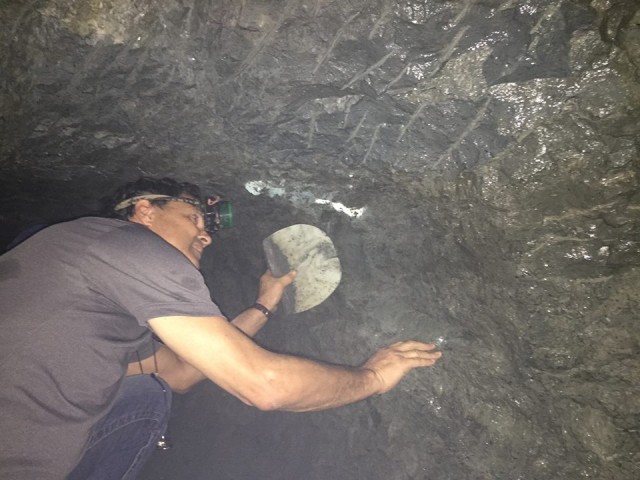
Indonezijski opal - terenski izvještaj Paula Sedawieja
 Posjetio sam novi rudnik opala u Bantenu, koji se nalazi u blizini Jakarte u Indoneziji. Opal je ovdje otkriven 1995. godine i od tada je bilo različitih razina proizvodnje.
Posjetio sam novi rudnik opala u Bantenu, koji se nalazi u blizini Jakarte u Indoneziji. Opal je ovdje otkriven 1995. godine i od tada je bilo različitih razina proizvodnje.
Postoje tri glavna područja gdje se može pronaći novi opal.
- 1. Cikole - Maja
- 2. Rangkas - Bitung
- 3. Cikole
Područje Cikole ima puno drvenih fosila. Trenutno radi možda tridesetak ekipa i čini se da se kreću okolo i ne idu na duge rute. Prvi rudnik koji sam posjetio bio je plitki rudnik od samo 12 metara. Nalazi se u području s puno kiše pa se većina rudarstva obavlja u sušnom razdoblju koje traje od srpnja nadalje. Gornje strane rudnika bile su poduprte bambusom koji mi se nije činio čvrstim, a ljestve od pruća nisu bile dovoljno široke za jednu moju nogu.


Zidovi su bili zasićeni vodom, a u podnožju okna tekao je gotovo potok. Tada su mi rekli da je prošle godine 12 rudara poginulo zbog urušavanja zidova. Nema podupiranja ili potpore zidova koji su vrlo vlažni čak i duboko u rudniku. Tlo je teška, ljepljiva kaolinitna glina sive do smeđe boje s crnim mrljama nalik ugljenu posvuda. Prate klizišta u tlu koja imaju tendenciju stvaranja opala.

Čini se da postoji obilje drvenog fosilnog opala koji je ugljeno crne boje. Neki prirodni neobrađeni opali brže su se osušili nakon vlaženja, što je prilično neobično jer sam navikao raditi s materijalom Lightning Ridge. Drveni fosil činio se stabilnim, ali kristali su bili vrlo hidrofanski. Materijal se čini krhkim poput kamenja yowah i mekši je za rezanje u usporedbi s materijalom Ridge. U Jakarti postoji tržnica nakita gdje rudari mogu prodavati svoju proizvodnju.
Opaženi tretmani opala
Izložene su velike ploče crnog lončanog kamenja, ali su natopljene glicerinom. Čak su i veliki crni ukrasi natopljeni njime. Čini se da je to uobičajena praksa namakanja većine materijala. Postoje grubi komadi nakita izrađeni od osnovnih metala i oni su također natopljeni dječjim uljem. Čak i dobro kamenje ima dječje ulje na sebi, a to pripisujem činjenici da završna obrada nije komercijalna pa ulje skriva sve udubljenja, ogrebotine itd. Postoji tretman zagrijavanjem za drvene fosile u kojem se uzorak zamota u foliju, zagrijava s uljem i pijeskom i miješa. Stopa uspjeha nije jako visoka, ali s nekim materijalom dobiju lijepo iznenađenje. Neki komadi lončanog kamenja imaju glinu čvrsto pričvršćenu za sebe, a toplina je uklanja.

Trenutno imam osjećaj da ulje oživljava boju opala, a dodaje se smola kako bi zadržao sjaj. Vještine rezanja lokalnog stanovništva nisu dobre i mislim da bi mogli koristiti ulje i smolu kako bi dobili završnu obradu. Testirat ću neke drvene fosile u vibrirajućem bubnju kako bih dobio bolji trajni završetak. Drugi tretman naziva se prirodna toplina. To je kada se kamen stavi u vodu i ostavi na suncu bez ičega drugog tjedan dana.
Kažu da poboljšava tamnu boju kamena, ali sam neke prerezao na dva dijela i ne vidim nikakvu razliku unutra. Postoje neki prekrasni fosili opaliziranog drva koji su odlični kolekcionarski primjerci. Neki od opaliziranog drva čine odlično kamenje. Ovaj opal voli jaku sunčevu svjetlost i može izgledati zapanjujuće, ali pri slabom svjetlu vrlo je malo igre boja. Kamenje s crvenom bojom je prilično uobičajeno, ali većina će biti distancirana i pomalo olovna.

Konkulzije
Ipak je sjajno iskustvo za hobista rezanja crvenog kamena na crnom kamenu. Vidio sam jedan vrlo upečatljiv kamen star 7 godina koji je bio crven i impresivan, ali ga nisam vidio pri slabom svjetlu. Njegova baza je bila ugljeno crna.
Većina neobrađenog kamenja koje sam vidio klasificirala bi se kao N1 do N3, ali razina svjetline pri normalnom osvjetljenju je udaljena/tupa. Definitivno postoji tržište za ovaj opal. Sumnjam da bi neki mogli biti hidrofan, a neki se neobrađeni brzo suše. Kristali izgledaju zanimljivo, ali vidio sam samo nekoliko kristalnih kamenja za koje se navodi da su stari nekoliko godina i stabilni.
Poslao sam uzorke poznatom znanstveniku specijaliziranom za opal na testiranje i nadopunit ću ovo izvješće. Ostanite s nama.
Kupite vlastiti komad indonezijskog opala
Pretražite Opal Encyclopedia
Povezane aukcije
povezani članci
Boulder Opal je jedan od najpotcijenjenijih opala na tržištu. Saznajte više o ovom jedinstvenom opalu i pregledajte prekrasno kamenje koje imamo na prodaju.
29th May 2019
Wayne i Estella Sedawie, strastveni ljubitelji opala, osnovali su Opal Plus prije više od 14 godina i otkrili da je internet vrijedan alat. Upravo se tamo odvija većina međunarodnih transakcija tvrtke.
17th Oct 2018
Rođeni kamen za listopad je naš omiljeni dragi kamen, opal. Crni opali, meksički opali i etiopski opali su jedinstveni kao i ljudi rođeni u listopadu.
3rd Oct 2019
Najnoviji članci
Crni opali su najtraženija vrsta opala, s dubokim bazama koje daju dugu odsjaja na vrhu. Otkrijte upotrebu, svojstva, povijest i vrijednost crnih opala!
7th Dec 2025
Otkrijte kako se opali ocjenjuju i koji čimbenici utječu na njihovu cijenu. Od boje i svjetline do brušenja i podrijetla, saznajte kako se svaka vrsta opala procjenjuje - s primjerima cjenovnih raspona.
19th Jul 2023
Krenite na putovanje i saznajte više o ljekovitoj moći opala od naše gostujuće spisateljice Vivien Schapere iz Crystal Healing Techniques!
20th May 2023
Kategorije članaka
All there is to know about Opals including Black Opals, Ethiopian Opals & Boulder Opal
14 Članci
Check out our fascinating information and articles on all things amazing in the Opal world
41 Članci
Opal Auctions sellers who are approved as opal Verified Sellers
4 Članci





